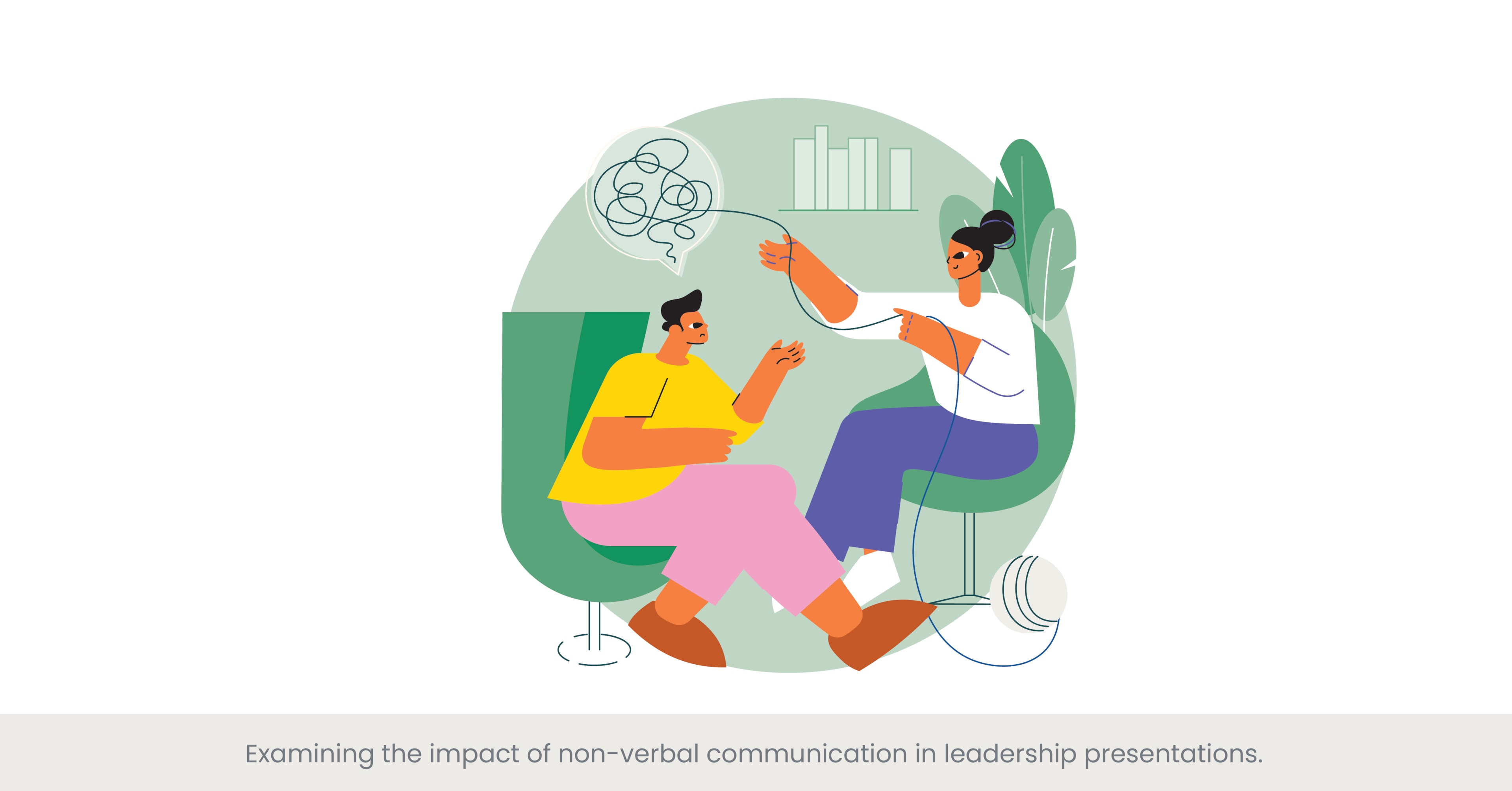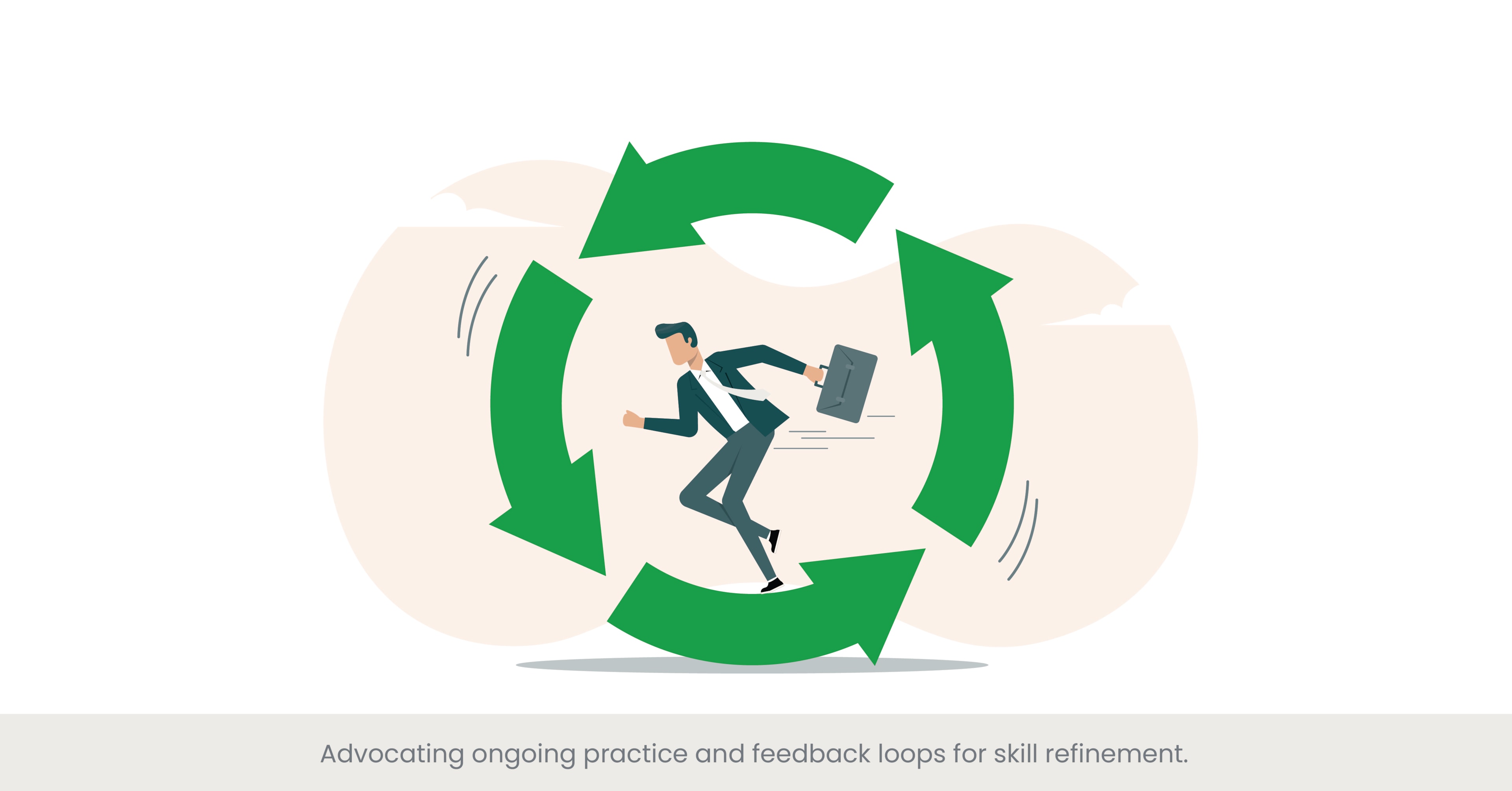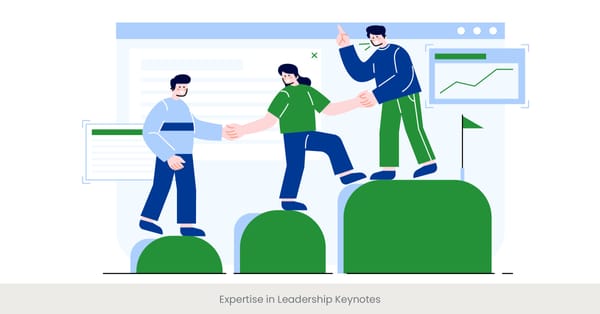
Outlining Key Focus Areas in Executive Presentation Skills Development

Defining Key Areas of Focus
When it comes to executive presentation skills, there are specific key areas that need attention. This sub-topic provides an overview of these crucial focus areas, which include clarity of message, audience engagement, non-verbal communication, and confidence in delivery. Mastering these aspects can transform an executive's ability to deliver powerful and impactful presentations. It’s essential to recognize that effective presentations go beyond just sharing information—they are about connecting with the audience and delivering a compelling message.
Deep Dive into Presentation Skills
Executive presentation skills encompass various competencies, such as clear and concise communication, strategic use of visual aids, and the ability to convey complex ideas simply. Background knowledge and expertise in these areas involves understanding the importance of preparation, structuring content logically, and utilizing storytelling techniques to maintain audience interest. Historically, great leaders have shown that presentation skills are not innate but developed through consistent practice and feedback. For example, Winston Churchill's renowned speeches were the result of meticulous preparation and practice.
Practical Applications
Consider the example of Steve Jobs, whose keynote addresses became iconic not just for their content but for the delivery style. Jobs's ability to engage his audience through storytelling, clear visuals, and a confident delivery transformed product launches into highly anticipated events. Similarly, Sheryl Sandberg, COO of Facebook, uses her presentation skills to communicate effectively, whether addressing a small team or speaking at a large conference. These examples illustrate the practical applications of honing executive presentation skills and their impact on leadership effectiveness.
Validating the Information
Research from Harvard Business Review emphasizes that leadership presentation skills are critical for executive success, highlighting that effective presentations can influence stakeholders and drive business outcomes. According to a survey by Prezi, 70% of employed Americans who give presentations agree that presentation skills are critical to their success at work. Furthermore, a study by Forbes indicated that executives who invest in presentation training see a significant improvement in their ability to persuade and inspire their teams. These statistics underscore the importance of continuous development in presentation skills for senior leaders.
Discussing the Benefits of Personalized Coaching for C-suite Members

The Importance of Personalized Coaching
Personalized coaching for C-suite members in leadership presentation skills offers tailored guidance that addresses specific needs and challenges. This sub-topic explores how individualized coaching helps executives refine their presentation skills, improve their delivery style, and build confidence. Personalized coaching is not a one-size-fits-all approach; it is about identifying and enhancing the unique strengths of each executive while addressing their weaknesses.
The Need for Customized Training
The necessity for personalized coaching arises from the diverse demands placed on senior leadership. Unlike generic training programs, personalized coaching focuses on the individual’s specific role, industry, and personal presentation style. This customized approach ensures that the coaching sessions are relevant and directly applicable to the executive’s real-world challenges. Historically, coaching has proven effective in various leadership contexts, from political leaders preparing for debates to CEOs getting ready for high-stakes investor meetings. The bespoke nature of coaching allows for a deeper dive into areas such as body language, voice modulation, and strategic messaging.
Impact of Personalized Coaching
One notable example of the benefits of personalized coaching is Satya Nadella, CEO of Microsoft. His transformation in public speaking and presentation skills is often attributed to targeted coaching that helped him develop a more engaging delivery style and improve his overall executive presence. Similarly, Mary Barra, CEO of General Motors, has benefited from personalized coaching, which has enabled her to communicate more effectively with stakeholders and lead with greater confidence. These real-world examples highlight how personalized coaching can significantly enhance leadership presentation skills, leading to more effective presentations.
Supporting Evidence
Studies support the effectiveness of personalized coaching for senior leaders. According to a report by the International Coach Federation (ICF), executives who received personalized coaching reported a 70% improvement in work performance, leadership effectiveness, and communication skills. Another study by the Center for Creative Leadership found that personalized coaching led to a 50% improvement in performance and productivity among senior executives. These findings demonstrate the substantial benefits of investing in personalized coaching to develop leadership presentation skills.
Exploring Methods to Enhance Storytelling Capabilities for Leaders

The Power of Storytelling in Leadership
Storytelling is a vital component of effective leadership presentation skills. This sub-topic delves into various methods leaders can use to enhance their storytelling capabilities, emphasizing the importance of narrative in engaging audiences and conveying powerful messages. Storytelling enables leaders to connect emotionally with their audience, making their presentations more memorable and impactful. By mastering storytelling techniques, leaders can turn complex data and abstract ideas into relatable and compelling narratives.
The Art and Science of Storytelling
Understanding the background of storytelling involves recognizing its roots in human culture and communication. Throughout history, storytelling has been a primary method for sharing knowledge, values, and experiences. For leaders, storytelling goes beyond just telling a tale; it involves structuring information in a way that resonates with the audience. Key elements include a clear beginning, middle, and end, as well as the use of vivid imagery, relatable characters, and a strong emotional appeal. Leaders must also practice their delivery style, using their voice and body language to enhance the story’s impact. The ability to craft and present stories effectively is a skill that can be developed through focused training and practice.
Successful Storytelling in Action
Consider the example of Indra Nooyi, former CEO of PepsiCo, whose storytelling skills have been instrumental in conveying her vision and strategies. She often used personal anecdotes and relatable stories to illustrate broader business points, making her presentations engaging and impactful. Similarly, Howard Schultz, former CEO of Starbucks, used storytelling to share the company's mission and values, creating a strong emotional connection with his audience. These leaders demonstrate how effective storytelling can enhance leadership presentation skills and drive audience engagement.
Supporting Research
Research highlights the effectiveness of storytelling in leadership presentations. According to a study by Stanford University, stories are up to 22 times more memorable than facts alone, underscoring the power of narrative in making information stick. Another study by the Harvard Business Review found that leaders who use storytelling are perceived as 20% more influential than those who do not. These findings highlight the critical role of storytelling in developing leadership presentation skills and the benefits it brings in terms of engagement and persuasion.
Examining the Impact of Non-Verbal Communication in Leadership Presentations

The Role of Non-Verbal Communication
Non-verbal communication is a crucial element of leadership presentation skills. This sub-topic explores the various aspects of non-verbal communication, such as body language, facial expressions, and eye contact, and their impact on the effectiveness of leadership presentations. Non-verbal cues can reinforce or undermine the spoken message, making it essential for leaders to be aware of and control their non-verbal signals. Mastering non-verbal communication can significantly enhance an executive's ability to engage and persuade their audience.
Understanding Non-Verbal Communication
Non-verbal communication encompasses all the ways people convey messages without words, including gestures, posture, and tone of voice. Understanding its background involves recognizing its importance in human interactions. Albert Mehrabian's communication model suggests that 55% of communication is through body language, 38% through tone of voice, and only 7% through words. This highlights the significant role non-verbal cues play in how messages are received and interpreted. For leaders, this means that their delivery style, including how they stand, move, and use their facial expressions, can greatly influence the effectiveness of their presentations.
Non-Verbal Communication in Action
Effective use of non-verbal communication can be seen in leaders like Michelle Obama, who is known for her powerful presence and engaging delivery. Her use of body language, such as open gestures and direct eye contact, helps her connect with her audience and convey confidence. Similarly, Elon Musk, CEO of Tesla and SpaceX, uses non-verbal communication effectively during his presentations. His animated gestures and enthusiastic tone enhance his message and engage his audience. These examples illustrate how mastering non-verbal communication can enhance leadership presentation skills and improve overall presentation impact.
Supporting Evidence
Research supports the critical role of non-verbal communication in presentations. A study by the Center for Nonverbal Studies found that non-verbal communication significantly influences audience perceptions of the speaker's credibility and confidence. Another research paper published in the Journal of Business Communication showed that effective non-verbal communication could increase audience retention of information by 30%. These statistics underscore the importance of developing strong non-verbal communication skills as part of leadership presentation training, highlighting its impact on delivering effective presentations.
Providing Strategies for Effectively Managing Presentation Nerves

The Challenge of Presentation Nerves
Managing presentation nerves is a critical component of leadership presentation skills. This sub-topic explores strategies that leaders can use to overcome anxiety and deliver confident presentations. Presentation nerves are common, even among experienced leaders, and can significantly impact the effectiveness of a presentation. By learning and practicing specific techniques, executives can manage their nerves, maintain their composure, and deliver their message with clarity and confidence.
Understanding Presentation Anxiety
Presentation anxiety, also known as glossophobia, is the fear of public speaking. It can manifest as physical symptoms such as sweating, shaking, and an increased heart rate, as well as mental symptoms like racing thoughts and self-doubt. Understanding the background of presentation anxiety involves recognizing its psychological roots, which often stem from fear of judgment or failure. Historical figures like Abraham Lincoln and Mahatma Gandhi experienced significant public speaking anxiety, yet they developed strategies to manage their nerves and become effective communicators. This shows that even the most renowned leaders have faced and overcome this challenge.
Overcoming Presentation Nerves
Prominent leaders like Warren Buffett have publicly discussed their struggles with presentation nerves. Buffett overcame his fear of public speaking by taking a Dale Carnegie course, which helped him develop techniques to manage his anxiety and improve his presentation skills. Similarly, Oprah Winfrey has shared how she uses deep breathing exercises and visualization techniques to calm her nerves before speaking engagements. These examples demonstrate that managing presentation nerves is a skill that can be developed through practice and the use of specific strategies.
Supporting Strategies
Research offers various strategies to help manage presentation nerves. According to the American Psychological Association, techniques such as deep breathing, progressive muscle relaxation, and visualization can reduce anxiety and improve performance. A study published in the Journal of Applied Psychology found that preparation and practice significantly decrease presentation anxiety, with participants reporting up to a 40% reduction in nervousness. Additionally, Harvard Business Review suggests that reframing nervousness as excitement can improve presentation delivery. These strategies, supported by research, provide valuable tools for leaders to manage their nerves and deliver effective presentations.
Highlighting Techniques for Improving Audience Engagement and Feedback

The Importance of Audience Engagement
Improving audience engagement and feedback is essential for delivering successful presentations. This sub-topic highlights techniques that leaders can use to keep their audience engaged and encourage valuable feedback. Engaged audiences are more likely to retain information, be persuaded by the message, and provide constructive feedback, which is crucial for continuous improvement. Effective audience engagement is a key component of leadership presentation skills, ensuring that the message is not only heard but also resonates with the audience.
Understanding Audience Engagement
Audience engagement involves capturing and maintaining the audience's attention throughout the presentation. This can be achieved through various methods such as interactive elements, compelling storytelling, and the strategic use of visual aids. Background information on audience engagement includes the psychological principles of attention and retention, as well as the role of feedback in refining presentation skills. Historically, successful orators like Martin Luther King Jr. and Winston Churchill utilized techniques such as rhetorical questions, emotional appeals, and dynamic delivery styles to engage their audiences effectively. Understanding these principles can help leaders design presentations that are both engaging and impactful.
Techniques in Action
Leaders like Jeff Bezos, founder of Amazon, effectively engage their audiences by using clear, concise language and compelling stories that highlight key business concepts. Bezos often integrates data and real-world examples to make his points more relatable and engaging. Another example is Brene Brown, whose TED Talks are renowned for their ability to captivate audiences through powerful storytelling and authenticity. Brown's engaging delivery and interactive approach encourage audience participation and feedback. These examples demonstrate how leaders can use various techniques to improve audience engagement and make their presentations more effective.
Supporting Techniques
Research supports the effectiveness of various techniques for audience engagement. A study by the University of Minnesota found that presentations incorporating interactive elements such as polls and Q&A sessions can increase audience engagement by 50%. According to a report by Gallup, speakers who use storytelling see a 30% increase in audience retention and engagement. Additionally, the use of visual aids, as highlighted in a study by the University of California, can enhance comprehension and recall by 40%. These findings validate the importance of employing diverse techniques to engage the audience and encourage feedback during presentations.
Introducing Advanced Rhetorical Techniques to Influence and Persuade

The Power of Rhetorical Techniques
Advanced rhetorical techniques are powerful tools in leadership presentation skills, enabling leaders to influence and persuade their audience effectively. This sub-topic explores various rhetorical techniques, such as ethos, pathos, and logos, and how they can be strategically employed to enhance the impact of a presentation. Mastering these techniques allows leaders to deliver their message more convincingly, foster audience engagement, and drive desired outcomes.
The Foundations of Rhetoric
Rhetoric, the art of persuasion, has been studied and practiced since ancient times. Aristotle defined rhetoric as the ability to identify the means of persuasion in any given situation. The three main pillars of rhetoric are ethos (credibility), pathos (emotional appeal), and logos (logical argument). Understanding these foundations is crucial for leaders aiming to enhance their presentation skills. Ethos involves establishing the speaker’s credibility and trustworthiness, pathos connects with the audience’s emotions, and logos appeals to their logical reasoning. Historical figures like Socrates, Cicero, and more recently, Martin Luther King Jr., have effectively used rhetorical techniques to influence and inspire their audiences.
Rhetoric in Leadership Presentations
Barack Obama is a prime example of a leader who masterfully uses rhetorical techniques. His speeches often combine ethos, pathos, and logos to create compelling narratives that resonate with diverse audiences. For instance, in his 2008 victory speech, Obama used pathos by invoking a sense of hope and unity, ethos by highlighting his personal journey and credibility, and logos by outlining clear, logical plans for the future. Similarly, Sheryl Sandberg, in her TED Talk “Why We Have Too Few Women Leaders,” uses a mix of personal anecdotes (pathos), statistical data (logos), and her position as COO of Facebook (ethos) to persuade her audience. These examples illustrate how advanced rhetorical techniques can enhance leadership presentation skills.
Supporting Research
Research underscores the effectiveness of rhetorical techniques in presentations. A study published in the Journal of Communication found that speeches incorporating ethos, pathos, and logos were 60% more persuasive than those lacking these elements. Additionally, Harvard Business Review emphasizes that leaders who skillfully use rhetorical techniques can significantly enhance their influence and ability to drive change. According to a survey by the Center for Creative Leadership, executives who receive training in rhetorical skills report a 45% improvement in their presentation effectiveness. These findings highlight the importance of mastering advanced rhetorical techniques for impactful leadership presentations.
Reviewing Case Studies of Successful Executive Presentations

Learning from Successful Presentations
Reviewing case studies of successful executive presentations provides valuable insights into effective business presentation techniques and strategies. This sub-topic examines notable examples of executive presentations that have achieved significant impact, highlighting the elements that contributed to their success. By analyzing these case studies, leaders can learn practical lessons and apply them to enhance their own presentation skills. Understanding what makes a presentation successful is crucial for developing leadership presentation skills that resonate with audiences and achieve desired outcomes.
Key Elements of Successful Presentations
Successful executive presentations typically share several key elements, including clear messaging, engaging delivery, effective use of visual aids, and strong emotional appeal. These presentations are meticulously planned and rehearsed, ensuring that every aspect, from the opening statement to the closing remarks, aligns with the intended message. Historical examples of successful presentations often involve leaders who have mastered the art of storytelling, used data to support their arguments, and demonstrated confidence and credibility. The background study of these elements helps leaders understand the critical components of effective presentations and the importance of integrating them into their own practices.
Case Studies in Action
One exemplary case study is Steve Jobs’s 2007 iPhone launch presentation. Jobs’s presentation is often cited as a masterclass in engaging delivery and clear messaging. He used storytelling to build anticipation, incorporated compelling visuals, and demonstrated the product in a way that was both informative and captivating. Another notable example is Sheryl Sandberg’s TED Talk on gender equality in the workplace. Sandberg effectively used personal anecdotes, supported her points with data, and maintained a confident and approachable demeanor, making her presentation both impactful and memorable. These case studies illustrate how successful executives leverage their presentation skills to influence and inspire their audiences.
Supporting Evidence
Research and expert analyses support the effectiveness of the techniques used in these successful presentations. According to a study by Duarte, Inc., presentations that incorporate storytelling and strong visuals are 43% more persuasive than those that do not. The Harvard Business Review also highlights that executives who use data to back up their stories are seen as more credible and trustworthy, enhancing their overall presentation impact. Additionally, a report by McKinsey & Company emphasizes the importance of rehearsal and preparation, noting that the most successful presentations often involve extensive practice to ensure smooth delivery. These references provide a strong foundation for understanding the elements that contribute to successful executive presentations.
Advocating Ongoing Practice and Feedback Loops for Skill Refinement

The Necessity of Continuous Improvement
Ongoing practice and feedback are essential for refining leadership presentation skills. This sub-topic emphasizes the importance of continuous improvement through regular practice and feedback loops. Effective presentations require not only initial preparation but also consistent effort to refine and enhance skills. Leaders who prioritize ongoing practice and seek constructive feedback can significantly improve their delivery, boost their confidence, and achieve greater success in their presentations.
The Role of Practice and Feedback
The role of practice in developing presentation skills cannot be overstated. Practice helps individuals become more familiar with their material, reduce anxiety, and improve their overall delivery. Feedback, on the other hand, provides valuable insights into areas of improvement that may not be apparent to the speaker. Historically, many great orators and leaders have relied on rigorous practice and feedback to hone their skills. For example, Winston Churchill, known for his powerful speeches, practiced extensively and sought feedback from trusted advisors to perfect his delivery. Understanding the background and significance of these elements highlights their critical role in leadership presentation training.
Practical Applications of Practice and Feedback
A notable example of the benefits of ongoing practice and feedback is Jeff Bezos, founder of Amazon. Bezos is known for his meticulous preparation for public appearances and presentations. He practices his speeches multiple times, often in front of a small, trusted group who provide feedback to help him improve. Another example is Oprah Winfrey, who credits her success as a speaker to constant practice and a willingness to accept and act on feedback. These leaders demonstrate that continuous practice and constructive feedback are key to developing and maintaining high-level presentation skills.
Supporting Research
Research supports the effectiveness of practice and feedback in skill refinement. A study by the University of California, Los Angeles (UCLA) found that individuals who regularly practice their presentations and seek feedback show a 35% improvement in delivery and confidence. According to the Journal of Applied Psychology, feedback loops can enhance performance by up to 25%, as they provide speakers with specific, actionable insights. Harvard Business Review also emphasizes that leaders who invest time in ongoing practice and actively seek feedback are more likely to deliver impactful and effective presentations. These findings underscore the importance of continuous practice and feedback for refining leadership presentation skills.
Emphasizing the Role of Executive Presence in Effective Presentations

Defining Executive Presence
Executive presence is a crucial element in effective presentations, encompassing a leader's ability to project confidence, authority, and authenticity. This sub-topic explores how executive presence impacts leadership presentation skills and why it is essential for engaging and influencing an audience. Executive presence is not just about what leaders say but also how they say it, including their body language, vocal tone, and overall demeanor. Cultivating executive presence enables leaders to command attention, build credibility, and deliver their message with impact.
Components of Executive Presence
The components of executive presence include confidence, communication skills, and the ability to remain composed under pressure. Confidence is demonstrated through a strong, clear voice and assured body language. Effective communication skills involve clarity of message, engaging delivery, and active listening. Composure under pressure means maintaining calm and poise, even in challenging situations. Historical figures such as John F. Kennedy and Margaret Thatcher exhibited strong executive presence, which contributed to their effectiveness as leaders. Understanding these components helps leaders develop the qualities necessary to enhance their presentation skills and engage their audience.
Demonstrating Executive Presence
An example of executive presence in action is Barack Obama, whose speeches often reflect his ability to project confidence, connect with his audience, and convey his message with clarity and authority. His use of eye contact, deliberate pauses, and controlled gestures enhances his executive presence. Another example is Indra Nooyi, former CEO of PepsiCo, who is known for her composed and confident demeanor during presentations. Nooyi's ability to articulate her vision and connect with her audience through authentic communication has been a key factor in her leadership success. These examples illustrate how executive presence can elevate leadership presentation skills and make presentations more effective.
Supporting Research
Research highlights the importance of executive presence in leadership. A study by the Center for Talent Innovation found that executive presence accounted for 26% of what it takes to get promoted. The same study identified three key aspects of executive presence: gravitas (how you act), communication (how you speak), and appearance (how you look). According to a survey by Forbes, 81% of respondents believe that executive presence influences career advancement. Additionally, Harvard Business Review emphasizes that leaders with strong executive presence are more likely to inspire trust and motivate their teams. These references underscore the critical role of executive presence in delivering effective presentations and enhancing leadership capabilities.
Frequently Asked Questions (FAQs)
1. What are the 5 P's of presentation skills?
The 5 P's of presentation skills are Plan, Prepare, Practice, Present, and Perform.
Plan: Define the objectives, understand the audience, and begin to structure the content logically.
Prepare: Gather materials, design visuals, and refine the content for clarity and impact.
Practice: Rehearse the presentation multiple times to build confidence and ensure smooth delivery.
Present: Deliver the presentation confidently, using strong body language, clear speech, and engaging delivery.
Perform: Evaluate the first presentation design's effectiveness, gather feedback, and identify areas for improvement.
2. How do you demonstrate leadership in a presentation?
Demonstrating leadership in a presentation involves several key elements:
Confidence: Displaying assurance in your delivery style and maintaining composure.
Clarity: Communicating your point or message clearly and concisely to ensure understanding.
Engagement: Interacting with the audience and maintaining a rapport and their interest throughout the presentation.
Credibility: Establishing trust and authority by providing well-researched information and presenting it with conviction.
Vision: Inspiring the audience by articulating a clear and compelling vision or goal.
3. Why are presentation skills important for a leader?
Presentation skills are crucial for leaders because they enable effective communication of ideas, strategies, and visions. Key reasons include:
Influence: Persuading and motivating team members, stakeholders, and clients.
Clarity: Ensuring complex ideas are understood and actionable.
Engagement: Keeping the audience interested and involved, which is essential for collaboration and buy-in.
Credibility: Establishing authority and trust through confident and articulate communication.
Inspiration: Inspiring and rallying the team towards common goals and visions.
4. What are the 7 presentation skills?
The 7 presentation skills essential for effective communication are:
Preparation: Thoroughly researching and organizing content to deliver a well-structured presentation.
Clarity: Ensuring the message next presentation is clear and easily understood by the audience.
Engagement: Using techniques to keep the audience interested and involved in person show.
Confidence: Displaying self-assurance and maintaining composure during the presentation.
Non-Verbal Communication: Effectively using body language, facial and head expressions, and eye contact to reinforce the message.
Adaptability: Being flexible and responsive to the audience's reactions and feedback.
Storytelling: Using narrative techniques to make the presentation more relatable and memorable.



%20(1).jpg)
%20(1).jpg)


